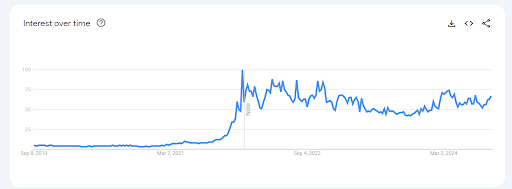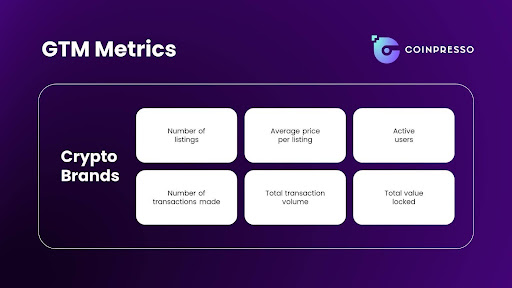Data from crypto analysts Chainalysis, published in the Crypto Spring Report 2024 demonstrates the continued growth of the cryptocurrency industry by active users, with the number of active wallets surpassing 400 million for the first time.
As a result of this growth, more and more crypto brands are emerging to compete for their share of an industry valued at over two trillion dollars. To set themselves apart in an increasingly competitive space, these brands must adopt crypto-specific strategies and consider utilizing Web3 marketing services to thrive.
It is only through adopting a tailored and impactful web3 marketing strategy that crypto brands can evolve and grow in 2024 and beyond.
Understanding Web3 and Its Impact on Marketing
First, let’s refresh ourselves on what exactly Web3 is.
What is Web3?
The third iteration of the internet, Web3, is a catch-all term used to describe a movement towards decentralization, user privacy, and financial empowerment through the adoption of blockchain technologies and the smart contracts, cryptocurrencies, tokens, and NFTs that reside within them.
The difference between Web 2.0 and Web 3.0 is that 2 uses personally identifiable information such as email addresses and passwords that could be sold on for advertising purposes or exploited by hackers. Web3 uses only a public wallet address that is anonymous and cannot (in most cases) be linked to an identity.

This provides numerous benefits to the user, including:
Removed reliance on centralized intermediaries
Improved transparency, security, and control
Economic and financial incentives to participation in the ecosystem (see Brave Browser’s Basic Attention Token as an example).
Now, let’s look at how marketing efforts have evolved in the web3 space over time.
The Evolution of Marketing in the Web3 Era


After an explosion of interest in Web3 in 2021, expressed in the chart above as Google search volumes, Web3 continues to capture and hold the interest of millions around the world.
Web3 is early in its lifecycle, Web4 a long way off, and continues to evolve over time as any emerging and growing industry should.
Examples of how Web3 marketing has evolved since 2021 include:
The growth of community governance and engagement: many crypto brands are transitioning over time as part of their roadmaps into Decentralized Autonomous Organizations that are governed wholly by a community of token-holders, who are often rewarded for long-term loyalty and engagement.
Focus on token airdrops: a prominent way for early-stage projects and brands to grow a community is to offer an airdrop of tokens to, for instance, testnet users upon mainnet release, as part of an airdrop marketing strategy. This helps reward active participation, testing, and loyalty to users whose visions are aligned with the brands.
Moving towards the mainstream: there have been several major traditional advertising campaigns on Television and at sporting events post-Bitcoin spot ETF approval that have helped bring crypto into the mainstream consciousness.
Collaborative approach: Where traditional brands may see their competitors as something to ignore, Web3 marketing often relies heavily on collaborating with similar brands and through partnerships.
Ideology: as trust in centralized monopolies wanes in the face of, for instance, the recent Crowdstrike outage, decentralized projects can market their inherent security benefits.
Now that we have an improved understanding of what Web3 is and how Web3-specific marketing has evolved, let’s review the key components of your crypto brand’s new marketing strategy.
Key Components of a Web3 Marketing Strategy
While every marketing strategy will include elements unique and specific to your crypto brand’s mission, all strategies should include some or all of the following elements.
Decentralized Platforms and Communities
Decentralized Autonomous Organizations (DAOs), social media platforms such as Nostr and other on-chain or relevant community platforms such as Telegram groups have seen hundreds of millions of users flock to these alternatives.
On-chain Telegram games such as Hamster Kombat and Toncoin have seen massive success in the establishment and growth of these communities through this platform, and every crypto brand should consider X, Discord, and Telegram as essential to their community management strategy.
Tokenomics and Incentives
Certain crypto brands and projects have developed successful marketing strategies in which airdrops are distributed to the stakers of certain coins, these airdropped tokens can then also be staked for further airdrops as part of a marketing strategy that rewards long-term holders.
Notable recent examples include Celestia and Dymension.
A new brand’s tokenomics typically include significant token allocations for community development and marketing purposes, which might have previously been allocated to team members.
NFTs as Marketing Tools
Bored Ape Yacht Club, Crypto Punks, and Pudgy Penguins are some of the best-known NFT communities and demonstrate the marketing tool potential of non-fungible tokens.
More recently, former President of the United States, Donald Trump, released successful NFT collections on the Polygon blockchain, demonstrating the power of NFT PR as a marketing strategy.
Beyond these key Web3-specific components of a marketing strategy, there are many other effective techniques for growing a crypto brand in 2024 and beyond.
Effective Web3 Marketing Techniques for 2024
Any emergent technology can seem complex and confusing at first, especially when a whole new canon of jargon emerges as a result. Web3 is no different.
Through the use of high-quality educational materials, the deployment of key opinion leaders, and the growth of passionate, helpful communities, crypto brands can scale their adoption.
Content Marketing and Education
Educational multimedia resources that can fully articulate a complex value proposition in a user-friendly way are a key technique for marketing Web3 brands in 2024.
Previous marketing efforts may have focussed on the technology itself and included complex jargon, but in today’s environment, accessibility is key.
A brand’s proposition must be understood by everyone, not just the builders, but the users. Marketing materials should focus on the outcomes driven by the tech, not the tech itself.
Influencer Marketing in the Web3 Space
Where previous celebrity endorsements of crypto brands have not always seen positive results, there is a burgeoning market of Key Opinion Leaders and influencers in specific crypto-related niches.
A great example is GameFi, as gamers were typically skeptical of blockchain technology and especially NFTs at first, feeling that it was being forced upon them.
Influencers in the space help bridge the gap between Web2 and Web3 gamers through educational content and their industry-impacting opinions.
Social Media and Community Engagement
Web3 social media management across channels such as X, Discord, Telegram, YouTube, and Reddit has enabled crypto brands to access existing audiences rather than simply create their own. By showing up in the places these audiences hang out, crypto brands can identify and engage with their perfect user and onboard them to their platforms.
For example, replies to posts on X or YouTube videos highlighting how the brand will offer solutions to known problems in an upcoming Ask-me-anything (AMA) session within their Discord is a great way to make a brand’s presence felt.
Leveraging Technology for Enhanced Marketing
Given the prominence crypto brands place on emerging tech, it makes perfect sense that they’d incorporate this within their marketing efforts. Let’s take a look at some examples below:
Utilizing AI and Data Analytics
The combination of rapidly improving Artificial Intelligence (AI) capabilities and advanced data analytics provides unparalleled insight to crypto brands, especially given the massive growth of available on-chain data.
Personalized marketing to, for instance, NFT holders, combined with predictive analytics around on-chain behavior can help crypto brands understand their holders in new ways and improve their relationships with better communication and marketing.
Smart Contracts and Automation
The capabilities of on-chain, self-executing smart contracts lend themselves nicely to the automation of marketing efforts, leading to the rapid creation of airdrop and loyalty programs.
For instance, a smart contract could recognize an accrued amount of testnet “points” a participant’s wallet holds and upon reaching a certain threshold, automatically distribute token rewards.
Building Trust and Transparency
A key tenet of Web3 ideology is around improving trust and transparency between brands and their audiences.
There are numerous examples of how to do this in 2024 and beyond, including:
Proof of reserves
Certified audits
Detailed and accessible team information
Published tokenomics
And more.
Ensuring Transparency in Your Marketing Efforts
An upfront commitment to transparency is a point of differentiation in 2024 that crypto brands can utilize, and could take the form of commitment to a roadmap, regular virtual team hangouts, a public team wallet address, and more.
Ethical Marketing Practices
Despite a one-time reputation as a new “wild west”, the crypto landscape is reaching new ethical heights as we get closer to semi-regulated or regulated status.
This means brands cannot ethically make misleading claims, guarantee profits, market to individuals in certain countries, and other specific considerations.
Measuring Success in Web3 Marketing
Key to any marketing strategy is the ability to measure and act upon results, with constant iteration always top of mind. Decentralized and agile web3 projects are typically able to make decisions and act upon them faster than their traditional counterparts, and capturing key metrics is an enabler of this.
Key Metrics for Evaluating Web3 Marketing Strategies
While traditional marketing metrics such as Return on ad spend (ROAS) and Return on investment (ROI) do apply to crypto brands, there are several Web3-specific metrics that must be considered, including:
Community growth & engagement
Daily/weekly/monthly active wallets
User retention
Total value locked
Transaction volume
Transaction value
Market cap
Circulating supply
The availability of public but anonymous on-chain data through blockchain explorers is a key differentiator for crypto brands, but there are other tools and platforms that can help with tracking performance.


Tools and Platforms for Tracking Performance
Below, you’ll find an inexhaustive list of useful tools and platforms for tracking the success of your project’s marketing:
Dune Analytics – this powerful tool allows for the easy creation of custom dashboards and data visualizations including on-chain data.
Google Analytics – useful for understanding an audience member’s behavior once they arrive on your project’s website.
Google Search Console – a reliable and valuable tool for Web3 SEO.
Summary of Key Points
In this article, we’ve covered the vital components and techniques for crypto brands looking to effectively market and grow their brands in 2024 and well into the future.
Have we missed something? Tag us @Coinpressoteam on X and let us know!


















